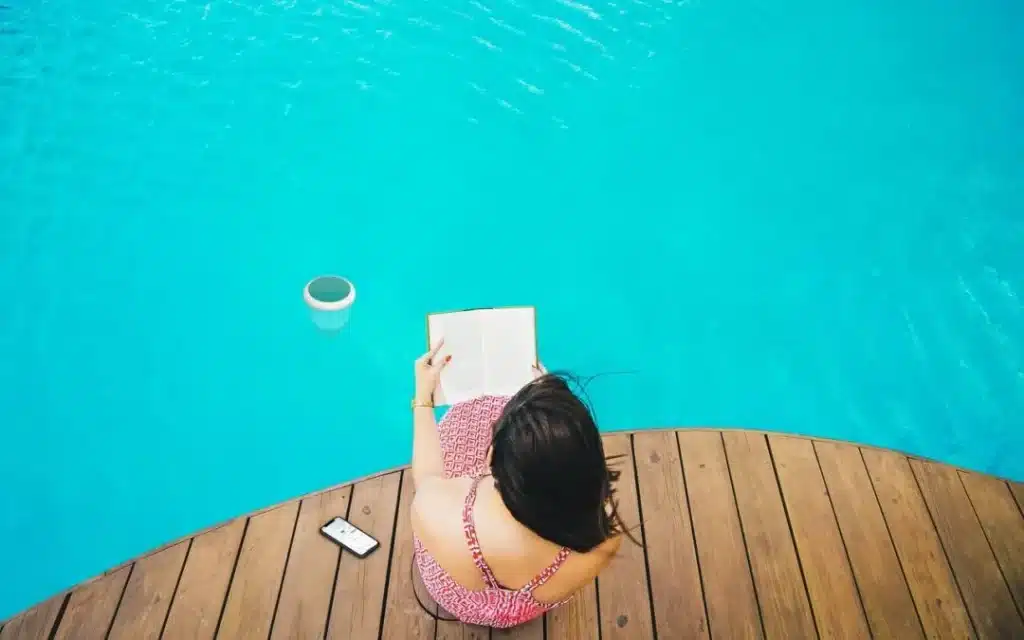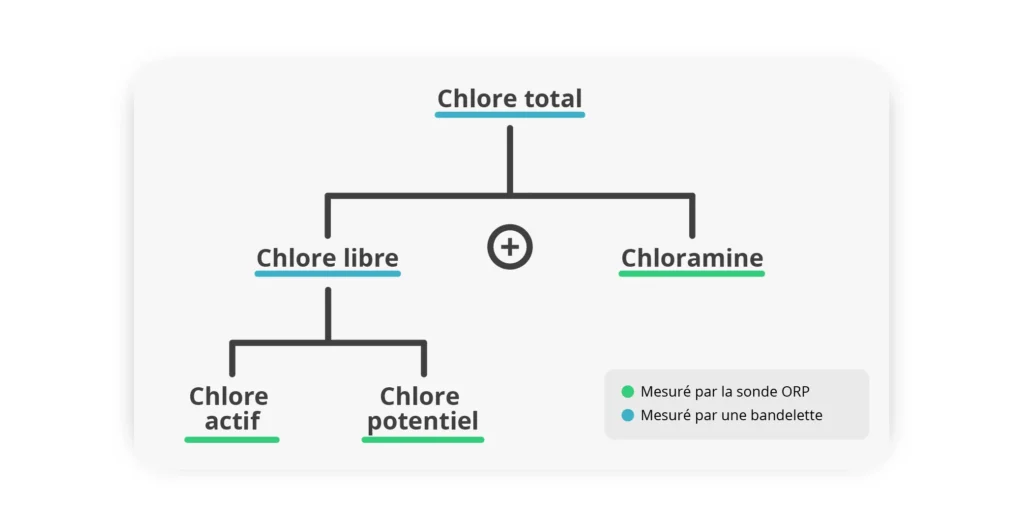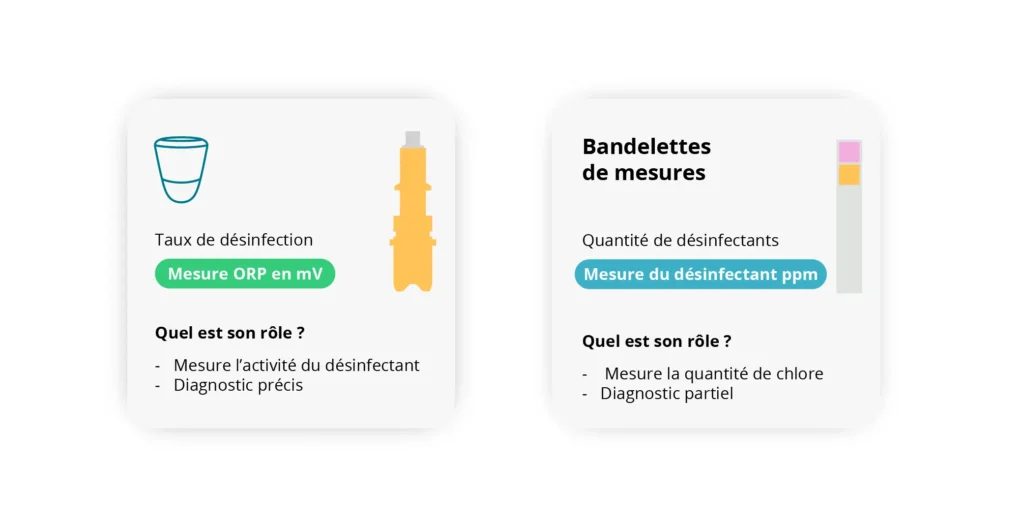Chlorine is the most common product used to treat pool and spa water. It is also the most economical treatment compare with bromine and salt. Its disinfectant property eliminates all micro-organisms in the water and it is an effective algicide. You hesitate in the choice of the treatment of your swimming pool or spa ? read this article to know everything.

Chlorine is a chemical element belonging to the halogens like fluorine and bromine. It is both a disinfectant and an oxidant, playing an essential role in maintaining healthy, balanced water. Like bromine, it is a preventive disinfectant and algicide. Chlorine levels vary according to the pH of the pool. If the pH is too high (pH>7,8), chlorine becomes ineffective.
It's the transformation of chlorine into chloramine (in contact with body pollutants) that creates this characteristic odor. In other words, it's possible to smell the quality of chlorine-treated water. If your pool or spa smells of chlorine, it's because the water is fairly polluted.
Chlorine for swimming pools comes in several forms: liquid, pebble or powder. The disinfecting power of chlorine does not change according to the type of packaging, but the speed at which it is diluted in the water does, and therefore its effectiveness over time. So it's perfectly possible to use several forms of chlorine, depending on your needs and the problem at hand.
Chlorine pebbles are placed either in your pool's skimmer or in a floating diffuser (for freestanding/above-ground pools). On contact with the water, the pebbles gradually dissolve. Their slow action helps maintain chlorine levels. This is the ideal form for regular maintenance of your pool or spa. Depending on the number of bathers and filtration time, chlorine pebbles should be added once or twice a week. There are also pebbles for shock chlorination (at the start of the season, or to quickly treat a water quality problem), which work very quickly.
Powder chlorine dissolves quickly in water and is fast-acting. It is often used as a shock treatment to treat green algae or when restarting your pool after winterizing.
Liquid chlorine has the reputation of being a little more difficult to dose and handle. The pool surround must be protected to prevent discoloration (watch out for splashes), and bathers must be prevented from entering the pool for several hours after pouring the product into the water. Liquid chlorine is rarely used by private individuals (unless their pool is equipped with a dosing pump). It is more commonly used in public pools.
There are two commercially available types of chlorine for disinfecting your pool or spa water, stabilized chlorine and non-stabilized chlorine.
It has a high disinfectant power, but UV rays can significantly reduce its disinfectant power within a few hours. After 3 hours' exposure to the sun, 5% of unstabilized chlorine and 70% of stabilized chlorine remain in your pool. You can top this up with a stabilizer at the start of the season. This product is more commonly used by spa owners (who have a cover) and indoor pool owners.
As its name suggests, it contains a stabilizer, cyanuric acid, which protects it from UV rays. This is the form of chlorine most commonly used in swimming pools for its comfortable and complete use. Be careful, however, as the stabilizer (which must be between 30 and 50 mg/L) accumulates in the water and blocks the disinfectant action of chlorine. What's more, there's no way of lowering it except by draining part of the pool water. Stabilized chlorine must therefore be dosed with the utmost precision, and measured weekly.
Chlorine is a highly potent chemical and must be handled with care: gloves, masks and goggles (for liquid chlorine). Store out of reach of children and pets, in a dry, well-ventilated place.
Depending on the measurement tools used, they do not all analyze the same chlorine.

First of all, you need to know that there are several types of chlorine: total chlorine, free chlorine, potential chlorine and active chlorine. When chlorine comes into contact with water, it is transformed into active chlorine and potential chlorine.
When chlorine turns into chloramine (also known as combined chlorine), on contact with organic matter (sweat, dead skin, etc.), or depending on water temperature and pH. Chloramines are responsible for the specific odor of swimming pools.
Not every chlorine molecule is responsible for or active in disinfection. Active chlorine is the only chlorine active in water disinfection. The more chloramines a water contains, the less active chlorine it contains.
Because some chlorines are not involved in water disinfection (total chlorine, free chlorine and potential chlorine), make sure that the measuring system you choose analyzes free chlorine, as it is this measurement that gives you the right information on water health.

Chlorine treatment offers many advantages. Firstly, it's a powerful algaecide and disinfectant that's easy to use. It's also the most economical product, compared with other water treatments such as salt and bromine. Finally, it's available everywhere (supermarkets, specialist stores, etc.).
The smell of chlorine, or more precisely chloramine, can be a real turn-off for some people. When incorrectly dosed, it can cause irritation to the eyes and mucous membranes, as well as discomfort to the skin. Secondly, chlorine is less UV-stable. If your pool is particularly exposed to the sun, it may be better to consider a salt treatment. Lastly, chlorine levels vary according to pH: this is a parameter that needs to be carefully and regularly monitored to maintain good water quality.
Water treatment for swimming pools and spas is undoubtedly the most classic of all treatments. Economical and practical, chlorine's effectiveness in disinfecting water is widely recognized. Nevertheless, it remains a chemical product that must be handled with great care to protect the health of bathers.